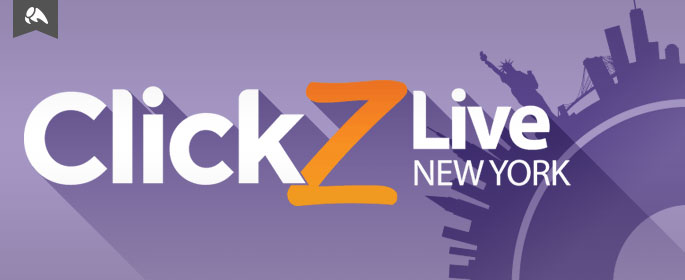
Good morning and welcome to Day 1 of ClickZ Live New York! I’m excited to be liveblogging sessions all day today and tomorrow from the front row. Grab a cup of coffee and stay with us for updates here – follow along on Twitter for more.

Today’s opening keynote is from Tim Goudie, director of social media and sustainability at The Coca-Cola Company (“The Man with the Sustainability Plan” is his introduction). Fittingly enough, that’s exactly what we’re covering this morning.
Coca-Cola has over 500 brands worldwide, 180 of which are focused on low or no calorie. He speaks of Coca-Cola changing its products to meet consumer tastes (like adding various teas internationally and Simply Orange juice) constantly – it’s not just soda.
Coca-Cola has a bold and ambitious mission statement – “To Refresh the World; Inspire Moments of Optimism and Happiness; Create Value and Make a Difference.” How do you do that, he asks, when people throughout the world have real issues, such as poverty and lack of drinking water? He says companies might not achieve world peace, but they can make a difference.
Tim shares stories of women in Africa whose connections to Coca-Cola have impacted their lives, as they worked as distributors, retailers, entrepreneurs, etc. These relationships have impacted not only these individuals, but the business itself, as Coca-Cola has engaged in local initiatives.

People asked, “How can I find, in the furthest corner of Africa, a cold Coca-Cola, but I can’t find medicine?” Because of questions like that, they’ve teamed up with agencies to teach them how to distribute medicine in the exact ways Coca-Cola is distributed (this is just one example of various initiatives).
Coca-Cola has a lot of programs. The role Tim came in to take is answering, “How do we tell these stories, how do we take these stories and making sure we get our message out in a balanced, ethical and transparent way?
And, how do we do this without inviting a storm and opening up a dark cloud over our heads?”

Traditionally, Coca-Cola has always had a large PR effort. They publish the story with the understanding that eventually that story will make it out to the consumer.
But there’s been a big shift in media. Digital media has grown to a point where Coca-Cola had to take it seriously. The majority of Coca-Cola’s audience is the size of China or India. They had to harness the power of social media. They had to begin creating content – and create an internal structure that allowed this content to be produced efficiently, using various skillsets that didn’t traditionally work together due to the company’s traditional hierarchy.
They moved away from corporate (company) speak, and moved to consumer speak (brand voice). They realized you can throw facts and figures at journalists and scientists, but these don’t always connect with the average consumer. That’s where we must say, “We have a message. We must craft a message that connects with the consumer (the art). We must have the right message reach the right consumer (the science).” Are people going to use their limited data plan to watch your corporate brand video? Probably not.
Tim shows us two videos – one suited for key corporate stakeholders. The other, for consumers. The one for consumers was hardly branded Coca-Cola. Coca-Cola understood the need to minimize branding in order to focus on the message they wanted to get across.
When sharing their content, Coca-Cola must focus on getting cleared global digital rights and global talent releases. This is a huge must for the brand, as its content gets so widely shared. They then execute their pre-planned content strategy (theirs is a 12-month content strategy with an editorial calendar, PPC strategy, social strategy and other campaign elements). They target very specifically, intentionally reaching exactly those they wish to see their content, which can be videos, infographics, websites and more. Coca Cola’s sustainability-related content isn’t about drinking Coca-Cola. It’s about empowering individuals. It’s about local programs, impacting change. These are what are driving brand awareness today.
Coca-Cola’s preferred marketing developer makes sure they don’t push out “great creative,” but actually identify the most effective creative. They test various pieces, and 24 hours later identify which is going to have the most success when promoted to the target audience. This, along with constant learning and iterating, has helped them identify which content really works. For Coca-Cola, it’s stories about real people being helped that consumers want to see.
And of course, measurement is a must. Tim speaks to how having the discussion of social media effectiveness (and efficiency) can be a tough sell in a company like Coca-Cola, which is used to massive, less-targeted television buys. But online tools give Tim the numbers to prove digital marketing’s effectiveness and to convince his team to put more focus, and budget, into digital marketing.
In 2014, there was a nearly 10% increase in consumers’ perception of The Coca-Cola Company, because people were becoming familiar with the work the company does for the first time due to digital marketing. They increased their brand sentiment overall, while decreasing spontaneous negative brand posts.
Tim’s wrapup:
- Focus on the consumer shift to digital media (mobile especially!).
- Work internally with a cross-functional team.
- Work with vendors and partners to fill skill gaps.
- Understand and use paid social media.
- Know the difference between your brand voice and your company (corporate voice).
- Balance conversations to ensure the stories and messages you’re focused on are getting the proper attention with the right audiences.
- Influence social media conversations.
- Finally, learn, iterate and reply.







